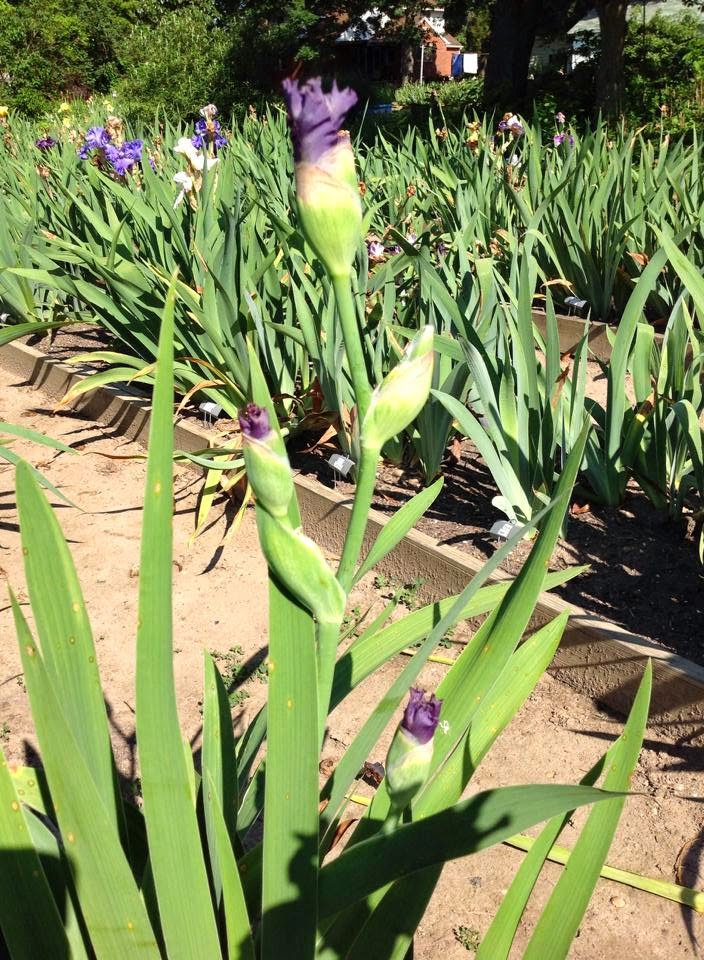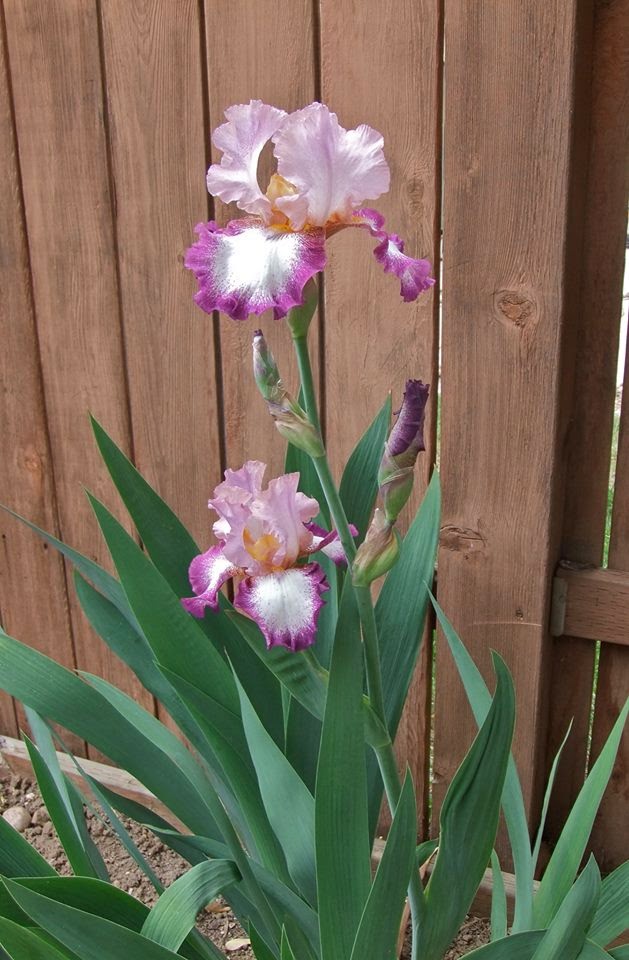by Dawn Mumford
My focus this time will still be on the "Oldies" before 1985 but I will focus on those 'historic' irises that won the Dykes Medal.Our iris patch in peak bloom.
There is a lot of information about the Dykes Medal found on The American Iris Society's website, as well as a really nice slide show showing all the Dykes Medal Winners. Just click here:
From the AIS website:
Dykes Memorial Medal: First awarded in 1927, The Dykes Medal is the highest award of the AIS. Awarded to no more than one iris per year, Irises are eligible as a Dykes Medal candidate for three years following the winning of a classification medal. Only AIS registered judges may vote.
Medals: Each year there are medals awarded to irises of each specific classification type. This is the top award for each AIS iris classification type. Irises are eligible as a candidate for a medal the second year after they receive an Award of Merit (AM), One medal for each classification is given each year (except for the very popular tall bearded which awards 3 Wister Medals each year).
Some years no award was given. Those years were 1930, 1931, 1934, 1946, 1960, 1969, 1987, and 1985. Once an iris is eligible it is only eligible for 3 years and then is no longer eligible. It can take 17 to 21 years before an iris is eligible.
Here are the "historic" irises that won the Dykes Medal between 1958 and 1984.
'Blue Sapphire'Schreiners Dykes Medal 1958
This iris was introduced in 1953. It is a blue self with a light silvery color.
"Swan Ballet'by Muhlestein Dykes Medal 1959
Photo courtesy of Mike Unser
'Eleanor's Pride' by E. Watkins Dykes Medal 1956
photo courtesy of Mike Unser
'Whole Cloth' by P. Cook Dykes Medal 1962
Photo courtesy of Sherry Austin
'Whole Cloth' by P. Cook Dykes Medal 1962
Photo courtesy of Carlos Ayento
'Amethyst Flame" by Schreiner Dykes Medal 1963
photo courtesy of Cathy Dudley
'Amethyst Flame' by Schreiner Dykes Medal 1963
Photo courtesy of Coleen Modra
'Allegiance'Paul Cook Dykes Medal 1964Described as violet, ultra-marine, frosty blue. Photographs close to true color. Very tall in our garden.
'Pacific Panorama'by Sexton Dykes Medal 1965Photo courtesy of Carlos Ayento
'Rippling Waters' by Orville Fay Dykes Medal 1966
This iris is a favorite of mine because of the ruffles and flutes. I like the contrasting beard as well. It really was ahead of its time for form, created nearly 50 years ago.
'Winter Olympics'Opal Brown Dykes Medal 1967
This is one of the first of all my irises. I received it in a trade from a friend back in 1985. Rather simple looking, but white shows so nicely in an evening garden. I thought that I was going to get rid of it because it was too simple (no ruffles or lace or flounces) but I think I will have to reevaluate that decision. A few years ago I told my husband that it had to go and he transplanted it to a part of the orchard where I rarely go. I think that it is time to bring it back.
'Stepping Out'Schreiners Dykes Medal 1968
This iris still wins awards today. It has form, texture, contrast, substance and more. Lovely in a vase with yellows and whites and deeper purples. Forty-five years old and many iris growers still include it in their catalogs. 'Skywatch' by Benson Dykes Medal 1970Photo courtesy of Mike Unser
'Debbie Rairdon'by Kuntz Dykes Medal 1971
Not the best picture because it was taken indoors. Among its attributes are vigorous habit and heavy substance.
.
![]()
'Babbling Brook'by Keith Keppel Dykes Medal 1972
This iris is described as a remarkable French blue. It stands out in my garden. It has veining which enhances the iris.
'New Moon' by Neva Sexton Dykes Medal 1973photo courtesy of Colleen Modra
'Shipshape'by Sanford Babson Dykes Medal 1974A massive medium blue flower that takes little care but stands out in a crowd. 'Pink Taffeta'by Ruldolph Dykes Medal 1975photo courtesy of Susanne SpickerThis is one of my favorite pinks. One note however, it won't look right in a pink depression glass vase because it has too much shrimp color in it.
'Kilt Lilt' by Gibson Dykes Medal 1976This ruffled and frilled plicata cries out for attention. The first plicata to win the Dykes since 'San Francisco' in 1927. Plicatas are those irises that are stitched or stippled with a margin of color on white or dots or peppering.
'Dream Lover"by E. Tams Dykes Medal 1977I'm always attracted to lavendars, orchids, and purples. This iris reminds me of periwinkle- that pretty little blue/purple flower that is a ground cover. Picture below. It has clean coloring which I love.
Photo credited to Perennials Image Gallery 'Bride's Halo'by Mohr Dykes Medal 1978
This one has a lovely precise 1/8 inch gold border around the falls, which unfortunately doesn't show well in this photo.
'Mary Frances'by Larry Gaulter Dykes Medal 1979
I spelled this wrong for years (Francis). This grows vigorously for us and is a lovely pastel. The graceful ruffling is beautiful.
'Mystique' by Joe Ghio Dykes Medal 1980This bitone (two shades of the same color) is said to be well liked by Californians (me too).
''Brown Lasso' by Buckles -Niswonger Dykes Medal 1981 Photo courtesy of Colleen Modra
Brown Lasso' by Buckles -Niswonger Dykes Medal 1981
Photo courtesy of Gerard Sirius
'Vanity' by Hager Dykes Medal 1982
photo courtesy of Susanne Spicker
I tend to gravitate to blues and pinks. This one is a lovely delicate pink without any shrimp color in it.
'Ruffled Ballet'by Elvan Roderick Dykes Medal 1983
I'm afraid this one doesn't increase well for us but the form and color is worth keeping anyway.
Another'Ruffled Ballet'by Elvan Roderick Dykes Medal 1983
Susanne Spicker describes the falls that are wide and full as "cocker spaniel ears". We like the generous falls on this one a lot.
'Victoria Falls'by Schreiners Dykes Medal 1984
This one is very stunning with only one fault that I know of. The stems are rather thin and in a wind storm they fall.
'Victoria Falls'by Schreiners Dykes Medal 1984 It made a beautiful clump for us this year. Do you grow any Dykes Medal winners? Do you plant them all together in the garden or do you put them with other irises? Which ones are your favorites?
I am very grateful to all my friends who so generously shared their photos. They shared more photos than I had room for, so I will do a continuation of this article in the future.

































































































